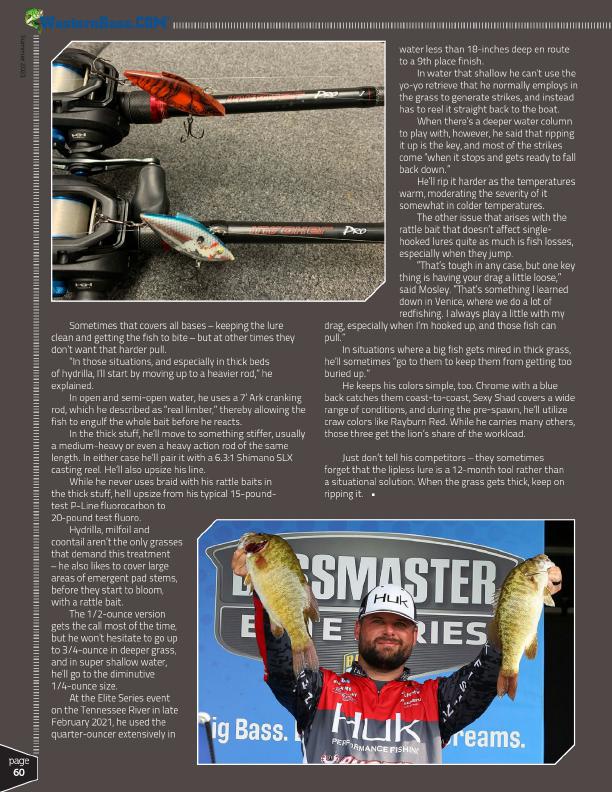
®
Summer 2021
page 60
Sometimes that covers all bases – keeping the lure clean and getting the fish to bite – but at other times they don’t want that harder pull.
“In those situations, and especially in thick beds of hydrilla, I’ll start by moving up to a heavier rod,” he explained.
In open and semi-open water, he uses a 7’ Ark cranking rod, which he described as “real limber,” thereby allowing the fish to engulf the whole bait before he reacts.
In the thick stuff, he’ll move to something stiffer, usually a medium-heavy or even a heavy action rod of the same length. In either case he’ll pair it with a 6.3:1 Shimano SLX casting reel. He’ll also upsize his line.
While he never uses braid with his rattle baits in the thick stuff, he’ll upsize from his typical 15-pound- test P-Line fluorocarbon to 20-pound test fluoro.
Hydrilla, milfoil and coontail aren’t the only grasses that demand this treatment – he also likes to cover large areas of emergent pad stems, before they start to bloom, with a rattle bait.
The 1/2-ounce version gets the call most of the time, but he won’t hesitate to go up to 3/4-ounce in deeper grass, and in super shallow water, he’ll go to the diminutive 1/4-ounce size.
At the Elite Series event on the Tennessee River in late February 2021, he used the quarter-ouncer extensively in
water less than 18-inches deep en route
to a 9th place finish.
In water that shallow he can’t use the
yo-yo retrieve that he normally employs in
the grass to generate strikes, and instead
has to reel it straight back to the boat.
When there’s a deeper water column
to play with, however, he said that ripping
it up is the key, and most of the strikes
come “when it stops and gets ready to fall
back down.”
He’ll rip it harder as the temperatures
warm, moderating the severity of it
somewhat in colder temperatures.
The other issue that arises with the
rattle bait that doesn’t affect single-
hooked lures quite as much is fish losses,
especially when they jump.
“That’s tough in any case, but one key
thing is having your drag a little loose,”
said Mosley. “That’s something I learned
down in Venice, where we do a lot of
redfishing. I always play a little with my drag, especially when I’m hooked up, and those fish can pull.”
In situations where a big fish gets mired in thick grass, he’ll sometimes “go to them to keep them from getting too buried up.”
He keeps his colors simple, too. Chrome with a blue back catches them coast-to-coast, Sexy Shad covers a wide range of conditions, and during the pre-spawn, he’ll utilize craw colors like Rayburn Red. While he carries many others, those three get the lion’s share of the workload.
Just don’t tell his competitors – they sometimes forget that the lipless lure is a 12-month tool rather than a situational solution. When the grass gets thick, keep on ripping it. •